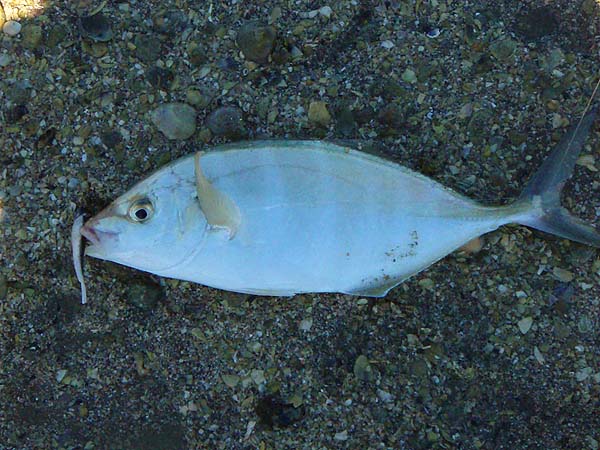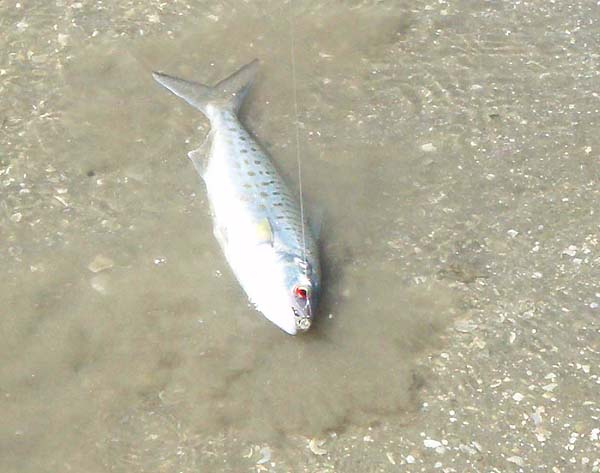 '
'Information Page.
Whangamata estuary.
A bit more stuff, this week, from Alan on fishing with soft plastics in New Zealand. He's been doing a bit more fishing from the shores of the Whangamata estuary.
Hi Mike,
SATURDAY 22 MARCH
The weather forecast was good for most of the weekend so a Saturday afternoon fishing session was negotiated on route to Whangamata. It had been 3 months since I had last cast a line into the estuary and I was keen to see whether the pre-Christmas Snapper were still in attendance. Low tide was at 2.30 pm which is not ideal but worth a shot. The high water tides were abnormally high but the lows not too low which meant there was a lot of water still in the estuary when I arrived. The weather was sunny, the sky cloudless and the mercury in the thermometer was nudging 25 degrees C when I set out from the carpark across the estuary at 12.30 pm.
I had decided in advance to target the successful area from December but when I arrived there was no 'gut' close to the shore and most of the moored boats were out to sea. It appeared that there was less water depth but it was hard to tell. The tide flow was flowing out strongly so I selected a ¼ oz. lead jig head, threaded on a 3” Powerbait Minnow (Black shad colour) and cast upstream in order to get the lure to the sea bed. The tide flow was not as strong as I had expected so the lure hit the bottom in short order and did not bounce along enticingly as was hoped. I switched to casting across and down but still could not get the drift that I was after. It took a while to figure out that a slightly downstream cast was the best option but this gave a very short drift. After 10 minutes of peppering the area with casts I decided to work my way downstream to where a couple of boats were at anchor and I knew that the water was deeper and the current more pronounced.
First cast under the nearest launch and I hooked and landed a large horse mussel which is always a good sign. A couple of casts later I felt an unusual nudge which may well have been a fish. I then noticed that there was the some surface activity at the confluence of a side stream and the main channel about 50 metres downstream. I moved carefully towards the disturbance, lobbed the lure close to the nearest launch and allowed it to swing into the junction of the two channels. At last the lure was bouncing along the bottom nicely and the rod tip was nodding appreciatively. The lure drifted into the target zone and was absolutely monstered. The fish shook its head and headed upstream strongly into the current. A constant drumming beat was transmitted through the rod blank and it was obvious that a small – medium trevally was attached via the lure. It, uncharacteristically, did not head into the deep water and chose to slug it out in the shallows which lead to a disappointing fight. I beached the 2 ½ lb fish quickly, despatched it and wrapped it in a wet towel to preserve the quality.
I systematically fished the area for the next 45 minutes and worked my way back to the start point upstream. The margins were alive with tiny smelt, small fish (3” long) and yellow eyed Mullet. Some of the Mullet were up to 18” long and were clearly visible in the calf deep water as they regularly passed on their way downstream with the ebbing tide, stopping occasionally to slurp tiny morsels from the bottom.
As the tide flow slackened the lure movement decreased alarmingly and most of the time it ended up firmly anchored on the bottom after the cast. To overcome this lack of movement I replaced the lead jig head with a much lighter resin head. This cut down the casting distance but dramatically increased the time taken to reach the bottom and the flutter of the lure. Second cast a 1.5 lb kahawai spanked the lure after it had landed on the bottom. I had just given the lure a short rip (more like a twitch) and allowed it to sink back to the bottom. This fish took to the air immediately and tail-walked around the shallows. It jumped about 4 times and pulled line from the spool in a couple of short bursts before gaining its freedom when the hook pulled.
Buoyed by this success I decided to return to the spot where I had landed the trevally as there was more chance of hooking up here due to the increased water depth and continuous food supply from the side stream. Again the lure got monstered on the second cast by a kahawai that was the mirror image of the first and again the hit came after a small twitch or rip of the lure. It did not take to the air but chose to zip around the margins pulling line from the spool in strong surges before being beached. This fish was released and swam away strongly despite appearing to have “blood” eye. There was no liquid blood emanating from the eye and the lure was well set in its mouth so it was obviously a prior injury.
The most encouraging sign from the outing was that I had managed to catch two fish as the tide approached dead low, which is normally the most unproductive phase of the tide cycle. The key to fishing soft plastics from the shore here seems to be making sure that the lure weight is correct. Too heavy and it moves unnaturally on the bottom, too light and it does not get down to where the fish are holding. What is obvious to me now is that the lure weight has to be changed regularly to compensate for the decrease in current velocity as the tide recedes. Allowing the lure to slowly flutter to the bottom and then retrieving with short rips and long pauses seems to work best.
I trust that the UK weather has improved and with it the fishing. Tight lines!
Best regards,
Alan Bulmer
Well that's another interesting session from Alan. I have to say that I feel as though I now know the area pretty well and if I ever go to NZ I'd have a fair idea how to get some enjoyable sport.
If you have any comments or questions about fish, methods, tactics or 'what have you.'get in touch with me by sending an E-MAIL to - docladle@hotmail.com
Trevally.
 '
'Kahawai
 '
'